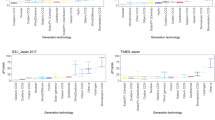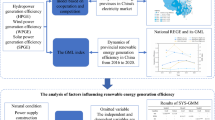Abstract
Affected by user demand and policy, the technological innovation speed and economic efficiency of different power technologies will change internally. By setting different policy scenarios, based on the levelized cost of electricity (LCOE) model, the paper comprehensively compared the impact of different policy portfolios and policy input intensity on the economics and stage of power technologies, and the market competitiveness evolution of coal power and renewable energy power is mainly analyzed. After 2020, with the increase in coal fuel prices and the acceleration of nuclear power technology learning, the LCOE of coal power has shown an upward trend, while the LCOE of nuclear power has shown the declining year by year. With the positive effects of technological innovation and diffusion, the LCOE of solar photovoltaic power (PV), and centralized solar power (CSP) technologies has also shown a downward trend year by year. In Scenario 1, continuing the existing energy policies, the LCOE of wind power, solar PV and CSP was significantly lower than coal power in 2040. In Scenario 2, implementing low-level coal resource tax, environmental tax, carbon tax and PV price subsidy, the LCOE of wind power and solar PV power was lower than coal power in 2030, and the LCOE of CSP was lower than coal power in 2040. In Scenario 3, implementing more rigorous energy policies, with the obvious economic advantages, the alternative of new energy power sources such as wind power and solar PV power is stronger.
Graphic abstract





Similar content being viewed by others
Availability of data and materials
All data generated or analyzed during this study are included in this published article.
References
Burhanettin C, Hakan A (2020) Technical and economic analysis of the conversion on an existing coal-fired thermal power plant to solar-aided hybrid power plant. J Fac Eng Archit Gazi Univ 35:1027–1045. https://doi.org/10.17341/gazimmfd.418417
Brian CM, William HN (2020) A 21st century low-carbon transition in US electric power: extent, contributing factors, and implications. Rev Policy Res 37:412–438. https://doi.org/10.1111/ropr.12388
Branker K, Pathak MJM, Pearce JM (2011) A review of solar photovoltaic levelized cost of electricity. Renew Sustain Energy Rev 15:4470–4482. https://doi.org/10.1016/j.rser.2011.07.104
Chen RR, Sun YL, Chen SM et al (2015) LCOE analysis of grid-connected photovoltaic power generation project. Renew Energy Res 33(5):731–735
Chang DH, Tian C, Zhang ZY et al (2020) Economic benefit analysis on photovoltaic power generation with LCOE model: the case of poverty alleviation project in rural areas of Yichang City. Res Environ Sci 33(10):2412–2420
CINIC (2019) China's photovoltaic exports are expected to grow steadily in 2019. http://www.cinic.org.cn/xw/schj/521676.html?from=groupmessage. Accessed 26 August 2020
CHYXX (2020) Analysis of Electricity consumption and average usage hours in 2019 in China and forecast of electricity consumption in 2020 http://www.chyxx.com/industry/202006/871284.html. Accessed 26 August 2020
Energy+ Environmental Economics (E3) (2012) Generation cost model for China. E3: San Francisco, CA, USA. https://ethree.com/public_projects/generation_cost_model_for_china.php. Accessed 26 August 2020
He MM (2019) Research on the economic analysis and development policies of distributed photovoltaic power generation project. Dissertation, North China Electric Power University
Huang H (2019) Research on cleaning of coal power industry under regulatory constraints and policy incentives in China. Dissertation, Beijing Jiaotong University
Hernandez-Moro J, Martınez-Duart JM (2012) Analytical model for solar PV and CSP electricity costs: present LCOE values and their future evolution. Renew Sustain Energy Rev 20:119–132
Lee DH (2016) Cost-benefit analysis, lcoe and evaluation of financial feasibility of full commercialization of biohydrogen. Int J Hydrogen Energy 41(7):4347–4357. https://doi.org/10.1016/j.ijhydene.2015.09.071
Li Y (2014) Research on economics and risk evaluation of offshore wind power. Dissertation, North China Electric Power University
Li YZ (2019) Comparison of LCOE and IRR indexes and analysis of applicable scenarios. Wind Energy 12:58–61
Lan L (2014) Analysis of characteristics and economic for new energy power generation. Dissertation, North China Electric Power University
Liu YX, Zheng RJ, Yuan JH (2020) The economics of peaking power resources in China: screening curve analysis and policy implications. Resour Conserv Recycl 158:104826. https://doi.org/10.1016/j.resconrec.2020.104826
National Renewable Energy Laboratory (NREL) (2010) Simple levelized cost of energy (LCOE) calculator documentation. https://www.nrel.gov/analysis/tech-lcoe-documentation.html. Accessed 26 August 2020
NEA (2020) Grid operation of photovoltaic power generation in 2019. http://www.nea.gov.cn/2020-02/28/c_138827923.htm. Accessed 26 August 2020
State Taxation Administration (STA) (2015) Announcement on issuing the "measures for the administration of the collection of coal resource tax (Trial)". http://www.chinatax.gov.cn/n810341/n810755/c1719741/content.html. Accessed 26 August 2020
State Council of the People’sRepublic of China (2017) Regulations for the Implementation of the environmental protection tax law of the People's Republic of China. http://www.gov.cn/zhengce/content/2017-12/30/content_5251797.htm. Accessed 26 August 2020
Talal A, Haluk D, Nurcin C et al (2016) A multiple perspective modeling and simulation approach for renewable energy policy evaluation. Comput Ind Eng 102:280–293. https://doi.org/10.1016/j.cie.2016.10.024
Tu CY (2019) Economic analysis and development policy research of wind power projects. Dissertation, North China Electric Power University
Viebahn P, Lechon Y, Trieb F (2011) The potential role of concentrated solar power (CSP) in Africa and Europe—a dynamic assessment of technology develop-ment, cost development and life cycle inventories until 2050. Energy Policy 39:4420–4430. https://doi.org/10.1016/j.enpol.2010.09.026
Wang JD, Zhou ZG, Zhao JN et al (2019) Optimizing for clean-heating improvements in a district energy system with high penetration of wind power. Energy 175:1085–1099. https://doi.org/10.1016/j.energy.2019.03.153
Xu Y, Kang JJ, Yuan JH (2018) The prospective of nuclear power in China. Sustainability 10(6):2086. https://doi.org/10.3390/su10062086
Xu Y, Yuan JH, Wang JX (2017a) Learning of power technologies in China: staged dynamic two-factor modeling and empirical evidence. Sustainability 9(5):861
Xu Y, Yang K, Xu HM (2017b) Dynamic integrated resource strategic planning model: a case study of China’s power sector planning into 2050. Sustainability 9(7):1177. https://doi.org/10.3390/su9071177
Xu Y, Yang K, Yuan JH (2020a) China’s power transition under the global 1.5 ℃ target: preliminary feasibility study and prospect. Environ Sci Pollut 27:15113–15129. https://doi.org/10.1007/s11356-020-08085-9
Xu Y, Yang K, Zhou JH et al (2020b) Coal-biomass co-firing power generation technology: current status. Chall Policy Implic Sustain 12(9):3692. https://doi.org/10.3390/su12093692
Xiong MP, Zhang Y, Yuan JH et al (2016) Economic evaluation and policy suggestion of Wind power in China. Energy China 10:20–26. https://doi.org/10.3969/j.issn.1003-2355.2016.10.004
Yuan JH, Na C, Xu Y et al (2016) Feed-In tariff for onshore wind power in China. Emerg Mark Finance Trade 52:1427–1437. https://doi.org/10.1080/1540496X.2016.1152797
Yuan JH, Sun SH, Zhang WH et al (2014) The economy of distributed PV in China. Energy 78:939–949. https://doi.org/10.1016/j.energy.2014.10.091
Zhao ED (2012) Study on the decarbonization development in China’s electricity sector. Dissertation, Wuhan University
Zhang Y, Yuan JH (2019) Economic analysis and Research on institutional barriers of Decentralized Wind power in China. J North China Electr Power Univ (Soc Sci) 5:30–43
Zheng XG (2020) China energy big data report (2020): Electric power (3). Polaris wind power website, http://news.bjx.com.cn/html/20200612/1080647-3.shtml
Zhang Y, Yuan JH, Zhao CH et al (2020) Can dispersed wind power take off in China: a technical and institutional economics analysis. J Clean Prod 256:120475. https://doi.org/10.1016/j.jclepro.2020.120475
Zhao CH, Zhang WR, Wang Y et al (2017) The economics of coal power generation in China. Energy Policy 105:1–9. https://doi.org/10.1016/j.enpol.2017.02.020
Funding
This study was funded by National Natural Science Foundation of China (71673085), Program for the Innovative Talents of Higher Education Institutions of Shanxi (PTIT) and Program for the Philosophy and Social Sciences Research of Higher Learning Institutions of Shanxi (2020W061). The authors would also like to acknowledge great thanks to anonymous reviewers for their valuable comments which largely improve the academic quality of this paper. The usual caveats apply.
Author information
Authors and Affiliations
Contributions
All authors contributed to the study conception and design. Data collection and analysis were performed by ZY and JY. The first draft of the manuscript was written by YX and all authors commented on previous versions of the manuscript. All authors read and approved the final manuscript.
Corresponding author
Ethics declarations
Conflict of interest
The authors declare that they have no competing interests.
Additional information
Publisher's Note
Springer Nature remains neutral with regard to jurisdictional claims in published maps and institutional affiliations.
Rights and permissions
About this article
Cite this article
Xu, Y., Yang, Z. & Yuan, J. The economics of renewable energy power in China. Clean Techn Environ Policy 23, 1341–1351 (2021). https://doi.org/10.1007/s10098-021-02031-0
Received:
Accepted:
Published:
Issue Date:
DOI: https://doi.org/10.1007/s10098-021-02031-0




